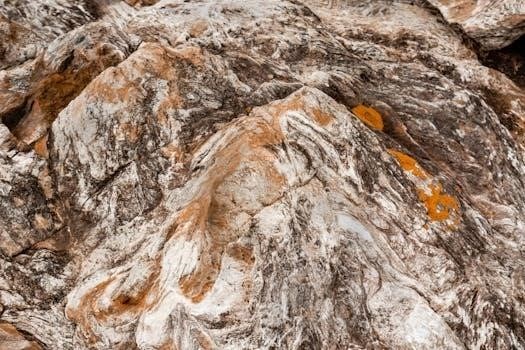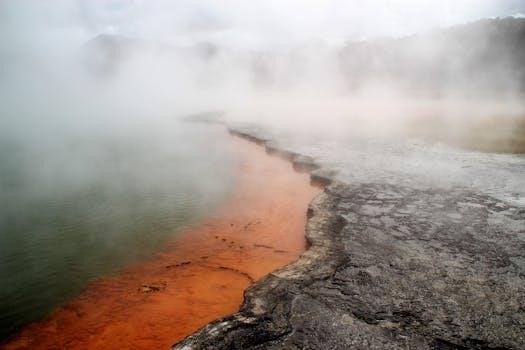Geology is a young science, yet it helps us understand our world․ Rocks and minerals are fundamental natural resources that form Earth’s crust․ Minerals are the building blocks of rocks, and are important for economic well-being and understanding the earth’s processes․ These materials are critical to many aspects of life․
What is Geology?
Geology, a relatively young science, focuses on understanding the Earth, its processes, and its history․ It delves into the planet’s composition, structure, and the forces that shape it․ This includes the study of rocks and minerals, which form the foundation of Earth’s crust․ Geology examines how these materials are formed, altered, and distributed, as well as the impact they have on the environment and human society․ The science also explores natural phenomena like earthquakes and volcanic eruptions․ Geologists investigate resources such as water, oil, and gas, and study Earth’s history through geological time․ They also analyze the interactions between the solid Earth, atmosphere, hydrosphere, and biosphere․ Geology integrates various scientific disciplines to provide a holistic understanding of our planet․ By studying these aspects, geologists contribute to crucial fields like resource management, hazard mitigation, and environmental conservation․ It’s a science vital for understanding our world․

The Importance of Rocks and Minerals
Rocks and minerals are fundamental to our existence, forming the very foundation of the Earth’s crust․ They are crucial natural resources that underpin numerous industries and aspects of our daily lives․ Rocks serve as parent materials for soils, influencing agricultural productivity․ They also contain groundwater supplies, essential for drinking and irrigation․ Minerals are vital components in construction materials, electronics, and countless other products․ The economic well-being of many regions is directly linked to their mineral resources․ Understanding rocks and minerals is essential for locating and developing plans for extracting these resources responsibly․ Furthermore, these materials provide insights into Earth’s history and geological processes․ They are essential for understanding the formation of mountain ranges, volcanic activity, and the movements of tectonic plates․ The study of rocks and minerals helps us mitigate natural hazards and manage environmental resources more effectively․ They also play a role in scientific research and technological advancements, making them incredibly important to society․

Minerals⁚ The Building Blocks of Rocks
Minerals are the basic chemical compounds that make up rocks․ They possess unique characteristics that distinguish them from one another․ These simple compounds form the foundation upon which all rocks are built, making them fundamental components of our planet․
Defining Minerals⁚ Composition and Structure
Minerals are naturally occurring, inorganic solids with a specific chemical composition and a definite crystalline structure․ This structure refers to the orderly arrangement of atoms within the mineral, which dictates its physical properties․ Unlike rocks, which are aggregates of minerals, each mineral has a consistent chemical formula or a range of compositions within specific limits․ For example, halite is always sodium chloride (NaCl)․ This fixed composition and structure result in unique characteristics that can be used to identify different minerals․ The structure also determines how a mineral will break, with some displaying cleavage along specific planes and others exhibiting fracture․ The way atoms bond together in a mineral leads to different forms, such as the cubic structure of halite or the hexagonal structure of quartz․ Understanding mineral composition and structure is essential for the identification of minerals and for comprehending their role in the formation of rocks and other geological processes․
Common Rock-Forming Minerals
While numerous minerals exist, only a select few are considered common rock-forming minerals․ These minerals are the primary constituents of most rocks and are essential for understanding geological processes․ Quartz, for example, is a very common mineral found in many rock types, known for its hardness and resistance to weathering․ Feldspars, including orthoclase and plagioclase, are also abundant and crucial components of igneous and metamorphic rocks․ Other important rock-forming minerals include micas, such as biotite and muscovite, which are characterized by their sheet-like structure․ Amphiboles and pyroxenes are dark-colored minerals found in many igneous and metamorphic rocks․ Calcite, a major component of limestone, is also a significant rock-forming mineral․ Halite, commonly known as table salt, is another common mineral․ These minerals, with their diverse chemical compositions and structures, form the basis for the wide variety of rocks present on Earth․ Their properties directly influence the characteristics of the rocks they comprise․

Rocks⁚ Aggregates of Minerals
Rocks are naturally occurring solids composed of one or more minerals; They are classified based on their mineral composition and formation environment․ These aggregates form the foundation of the Earth’s crust and provide valuable geological resources․ Rocks are built upon minerals․
Classification of Rocks by Formation
Rocks are broadly classified into three main categories based on their formation processes⁚ igneous, sedimentary, and metamorphic․ Igneous rocks form from the cooling and solidification of molten magma or lava․ Sedimentary rocks originate from the accumulation and cementation of sediments, which can include fragments of other rocks, minerals, and organic matter․ These sediments are often the result of weathering and erosion processes․ Metamorphic rocks are created from existing rocks that have been transformed by heat, pressure, or chemical reactions․ This transformation alters their mineral composition and texture․ Understanding these different formation processes is crucial for comprehending the geological history of an area and the distribution of various rock types; Each category of rocks possesses distinct characteristics, reflecting the conditions under which they were formed․ For instance, igneous rocks often have a crystalline structure, while sedimentary rocks may exhibit layering and fossils․ Metamorphic rocks can display foliation or other signs of alteration․ This classification system helps geologists analyze and interpret the Earth’s dynamic processes․
Igneous Rocks⁚ Formation from Magma
Igneous rocks, a fundamental category in geology, originate from the cooling and solidification of molten rock, known as magma or lava․ Magma, found beneath the Earth’s surface, cools slowly, allowing for the formation of larger crystals, resulting in intrusive igneous rocks․ Examples include granite and diorite․ In contrast, lava, which is magma that has erupted onto the surface, cools rapidly, leading to the development of fine-grained or glassy textures, resulting in extrusive igneous rocks, such as basalt and obsidian․ The composition of the original magma or lava plays a crucial role in determining the mineral makeup and overall characteristics of the resulting igneous rock․ These rocks can range in color and density, reflecting their diverse origins․ The texture and mineralogy of an igneous rock provide valuable clues about its cooling history and the conditions within the Earth’s crust or mantle where it was formed․ Igneous rocks are a vital part of the Earth’s geology, forming the bedrock of many regions and providing insights into volcanic activity and tectonic processes․
Sedimentary Rocks⁚ Formation from Sediments
Sedimentary rocks are formed through the accumulation and consolidation of sediments, which are fragments of pre-existing rocks, minerals, and organic matter․ These sediments are transported by various agents like water, wind, or ice and eventually deposited in layers․ Over time, the accumulated sediments undergo compaction due to the weight of overlying layers, and cementation, where dissolved minerals precipitate in pore spaces, binding the sediments together․ This process is called lithification․ Sedimentary rocks are categorized by their texture and composition, encompassing clastic rocks such as sandstone, shale, and conglomerate, which are composed of fragments of other rocks, as well as chemical rocks like limestone and halite, formed from precipitation of minerals from solutions․ Organic sedimentary rocks, such as coal, are formed from the accumulation and alteration of plant material․ These rocks often contain fossils, offering crucial information about past life and environments, making them vital for studying Earth’s history․ The study of sedimentary rocks provides insights into depositional environments, climate patterns, and the processes that shape Earth’s surface, making them a key element in geological investigations․
Metamorphic Rocks⁚ Transformation through Pressure and Heat
Metamorphic rocks are formed from pre-existing rocks—igneous, sedimentary, or even other metamorphic rocks—that have been transformed by intense heat and pressure․ This process, known as metamorphism, alters the mineral composition, texture, and structure of the original rock․ Metamorphism occurs deep within the Earth’s crust, typically in areas with tectonic activity, such as mountain-building zones․ The heat source can be from magma intrusions, while pressure can be caused by burial or tectonic forces․ Metamorphic rocks are classified based on their texture and mineral composition, which reflect the conditions they experienced during metamorphism․ Foliated rocks, such as slate, schist, and gneiss, display a layered or banded appearance due to the alignment of minerals under directed pressure․ Non-foliated rocks, such as marble and quartzite, lack this layering and are often formed under conditions of uniform pressure․ The specific minerals formed during metamorphism depend on the composition of the original rock and the temperature and pressure conditions․ Metamorphic rocks are valuable indicators of past tectonic and geologic events, providing insights into the dynamic processes that shape the Earth’s crust․

Geological Resources and Their Exploitation
Rocks and minerals are vital resources, crucial for industry and daily life․ Geologists are responsible for locating and developing plans for extracting these resources․ Their economic significance is immense, influencing various sectors, and it is linked to the materials found below the surface․
Economic Significance of Rocks and Minerals
The economic significance of rocks and minerals is profound, impacting numerous industries and aspects of daily life․ These geological resources are the basis of many industrial processes and are essential for manufacturing, construction, and technology․ For example, copper, silver, and gold, often found in hydrothermal deposits, are valuable metals used in electronics and jewelry․ Halite, or common table salt, is a critical mineral for food preservation and chemical production․ The rocks themselves, such as limestone, are used in construction and cement production, underscoring their importance in infrastructure development․ Furthermore, the economic well-being of states and regions is directly linked to the resources found below the surface, including groundwater supplies, mineral deposits, and parent materials for soils․ The mineral industries are a cornerstone of many economies, providing raw materials for various products and contributing to employment and revenue․ The exploitation of these resources requires careful planning and management to ensure sustainability and minimize environmental impact․ Therefore, understanding the geology of rocks and minerals is not just an academic pursuit but a crucial factor in economic growth and prosperity;